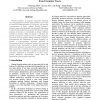Free Online Productivity Tools
i2Speak
i2Symbol
i2OCR
iTex2Img
iWeb2Print
iWeb2Shot
i2Type
iPdf2Split
iPdf2Merge
i2Bopomofo
i2Arabic
i2Style
i2Image
i2PDF
iLatex2Rtf
Sci2ools
ICTAI
2008
IEEE
2008
IEEE
Discovering Program's Behavioral Patterns by Inferring Graph-Grammars from Execution Traces
Frequent patterns in program executions represent recurring sequences of events. These patterns can be used to reveal the hidden structures of a program, and ease the comprehension of legacy systems. Existing grammarinduction approaches generally use sequential algorithms to infer formal models from program executions, in which program executions are represented as strings. Software developers, however, often use graphs to illustrate the process of program executions, such as UML diagrams, flowcharts and call graphs. Taking advantage of graphs’ expressiveness and intuitiveness for human cognition, we present a graph-grammar induction approach to discovering program’s behavioral patterns by analyzing execution traces represented in graphs. Moreover, to the efficiency, execution traces are abstracted to filter redundant or unrelated traces. A grammar induction environment called VEGGIE is adopted to facilitate the induction. Evaluation is conducted on an open source project JHotDraw...
Artificial Intelligence | Execution Traces | ICTAI 2008 | Program Executions | Program’s Behavioral Patterns |
| Added | 31 May 2010 |
| Updated | 31 May 2010 |
| Type | Conference |
| Year | 2008 |
| Where | ICTAI |
| Authors | Chunying Zhao, Keven Ates, Jun Kong, Kang Zhang |
Comments (0)

